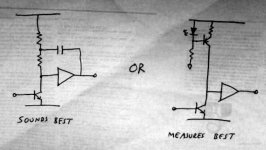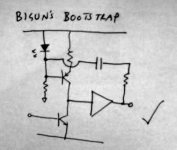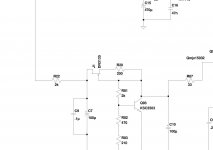Member
Joined 2009
Paid Member
Seems there are two schools of thought for single ended VAS load - a bootstrap (AKSA, DX, TGM1) or a Constant Current Source made out of a transistor and LED or out of two transistors. People say the bootstrap sounds better. Hugh of AKSA fame says (on this forum) this is because the bootstrap provides some +ve feedback that helps deal with the consequences of speaker back emf on the gnf, and he also says that the capacitor rolls off gain above 100kHz allowing less Cdom. Others, particularly EVA say (on this forum) that the bootstrap is bad and is clearly inferior. Some don't like the use of a large electrolytic cap. Yet people like OS say (on this forum) that the bootstrap sounds better.
So which one ?
So which one ?
Attachments
Member
Joined 2009
Paid Member
Is the answer to combine them - Bigun's Bootstrap ?
In simulations (notoriously unreliable for some) the current variations through the VAS device with a regular bootstrap can be simulated with Bigun's bootstrap using a modulated CCS (and the FFT looks 'nice' too). The advantage - no large electrolytic and you get to 'tune' the behaviour amongst others.
In simulations (notoriously unreliable for some) the current variations through the VAS device with a regular bootstrap can be simulated with Bigun's bootstrap using a modulated CCS (and the FFT looks 'nice' too). The advantage - no large electrolytic and you get to 'tune' the behaviour amongst others.
Attachments
Like many other similar questions, it depends. Of course I don't have sufficient knowledge to explain the physics/electronics, but I do know that if you don't have "ears" all you can do is "see" the measurements.So which one ?
If you believe that simpler is better, always do it with perfection because simplicity requires attention to details.
Is the answer to combine them - Bigun's Bootstrap?
My intuition is it will be worse. It will be good if we can provide the current exactly and sufficiently when we need it (just like what a ccs does) but without putting transistors there.
My approach is to pay attention to the power supply quality, short connection, capacitor quality and size.
IMHO either technique is viable and it simply depends on what you want. I've used both, bootstrap in earlier designs and generally a CCS these days, but I have recently been playing again with bootstrap. Bootstrap is nice and simple with just passives and has always sounded fine. Using a CCS offers a more technical solution that likely yields better measurements most times. So, are you more about measured performance or how you percieve the sound? I find the CCS crisp sounding and bootstrap a little softer, my own untrained perception. I don't have any sophisticated measurement tools, so I set up with a DMM and check on the oscilloscope to check the basics and then just listen.
My approach is to pay attention to the power supply quality, short connection, capacitor quality and size.
This doesn't mean that I'm a bootstrap guy. In a complex circuit/situation this simplicity may not give benefit at all. In a top quality system, I think ccs is a must.
From my experiments with modulation / no modulation of the current source in the Zen9 schematics, I concluded:
1) If one looks for drive and speaker control - better modulation and bootstrapping.
2) If one looks for ultimate transparency, microdetails and live-like sound - then no modulation, and removing as much as possible PCB traces and wires, where alternating currents walk. Shunt PS, even local ones for separate stages, is one of the measures for achieving this, it allows to localize the region where AC present. Important also to cut out the main PS from supplying AC currents to the schematic. These measures provide drastic positive effect for the sound, although measurements could be the same or even worse.
1) If one looks for drive and speaker control - better modulation and bootstrapping.
2) If one looks for ultimate transparency, microdetails and live-like sound - then no modulation, and removing as much as possible PCB traces and wires, where alternating currents walk. Shunt PS, even local ones for separate stages, is one of the measures for achieving this, it allows to localize the region where AC present. Important also to cut out the main PS from supplying AC currents to the schematic. These measures provide drastic positive effect for the sound, although measurements could be the same or even worse.
It works in the wrong direction: it will starve the PA stage from positive drive when it is the most needed: during the positive excursions.Is the answer to combine them - Bigun's Bootstrap ?
In simulations (notoriously unreliable for some) the current variations through the VAS device with a regular bootstrap can be simulated with Bigun's bootstrap using a modulated CCS (and the FFT looks 'nice' too). The advantage - no large electrolytic and you get to 'tune' the behaviour amongst others.
This could be adressed by tying the bootstrap cap to the emitter of the CCS.
Member
Joined 2009
Paid Member
I was wondering if anybody has tried Bigun's Bootstrap yet ? - believe it not, now that I no longer rely on spice I may actually try this out !
I'm also thinking about another type of 'CCS' that might sound better than a regular CCS and that would be the gyrator
http://www.diyaudio.com/forums/tubes-valves/147916-wavebourn-tower-iii-high-end-hybrid-amp.html
has anyone tried using a gyrator as a VAS load ? this is also what I'm thinking of trying. Only the resistor between base and collector on the gyrator device - move it over so that it's between base of the gyrator device and the amplifier output - and you get Bigun's Bootstrap again 😀
I'm also thinking about another type of 'CCS' that might sound better than a regular CCS and that would be the gyrator
http://www.diyaudio.com/forums/tubes-valves/147916-wavebourn-tower-iii-high-end-hybrid-amp.html
has anyone tried using a gyrator as a VAS load ? this is also what I'm thinking of trying. Only the resistor between base and collector on the gyrator device - move it over so that it's between base of the gyrator device and the amplifier output - and you get Bigun's Bootstrap again 😀
Perhaps a reason?
In some cases, bootstrap can sound better, and for a real reason. Assume that the output stage is somewhat underbiased. If severely so, the gain dips DRAMATICALLY as we go through zero, e.g. classic crossover distortion. The bootstrap cap feeds signal around the temporarily low gain output stage, and makes the overall gain variation less than it would otherwise be. This helps the xover distortion out a bit...
The constant current driver doesn't have this cap, so bad biasing is bad biasing, and the driver doesn't have a pass to pass a bit of helping current to the output stage.
Of course, in a well biased output stage, you'd never hear the effect, but output stage bias is notoriously unstable in many amps.
Warning: this is an intuition based result, not backed by simulations or math (yet), but still perhaps it might stir some discussion.
In some cases, bootstrap can sound better, and for a real reason. Assume that the output stage is somewhat underbiased. If severely so, the gain dips DRAMATICALLY as we go through zero, e.g. classic crossover distortion. The bootstrap cap feeds signal around the temporarily low gain output stage, and makes the overall gain variation less than it would otherwise be. This helps the xover distortion out a bit...
The constant current driver doesn't have this cap, so bad biasing is bad biasing, and the driver doesn't have a pass to pass a bit of helping current to the output stage.
Of course, in a well biased output stage, you'd never hear the effect, but output stage bias is notoriously unstable in many amps.
Warning: this is an intuition based result, not backed by simulations or math (yet), but still perhaps it might stir some discussion.
Member
Joined 2009
Paid Member
Hugh Dean has been said that bootstraps work better than CCS because they help mitigate the non-linear nature of the real world speaker and it's back emf so perhaps there's a link here between back emf and disrupted bias that the bootstrap helps stabilize. Graham Maynard always said that the back emf around zero crossing was a reason why AB amps sound bad and so he added a helper output device to force Class A operation around the zero crossing.
It implies that bootstrapping will have less influence on a Class A amplifier. I don't remember reading anybody who has noticed this though.
It implies that bootstrapping will have less influence on a Class A amplifier. I don't remember reading anybody who has noticed this though.
It's not Bigun's bootstrap but it is simple and works in built amp.
And I did not call it Dado's bootstap.
http://www.diyaudio.com/forums/solid-state/186981-bootstrapsccs-t-tmc.html
dado
And I did not call it Dado's bootstap.
http://www.diyaudio.com/forums/solid-state/186981-bootstrapsccs-t-tmc.html
dado
Back EMF
Another way to minimize this effect is to take global NFB at a point before the outputs , like from the drivers. The leach amp does this ,it takes HF feedback from the pre-drivers and LF/DC from the output. Amplifier damping factor/# of outputs , value of OP Re's , and of course topology will determine what effect ... if any , changing where you take GNFB , will have.
Back EMF can also affect the voltage stage directly with a common EF2 -EMF induced "droop". Running low impedance subs will show this.
Playing with the triple OP's has shown me 2 local feedback loops that I previously overlooked ...PS ripple and EMF.A different OP basestopper choice and better decoupling of the driver/predriver stage took care of this. I might try a bootstrapped triple with the cap taken off of the drivers just to see what I get - soundwise.
Yes , said that... and it does. And exactly for the reasons Hugh describes. A bootstrap does not beat everything . It does on an EF2 , but only as it "fixes" an imperfect current stage. 😀
OS
Another way to minimize this effect is to take global NFB at a point before the outputs , like from the drivers. The leach amp does this ,it takes HF feedback from the pre-drivers and LF/DC from the output. Amplifier damping factor/# of outputs , value of OP Re's , and of course topology will determine what effect ... if any , changing where you take GNFB , will have.
Back EMF can also affect the voltage stage directly with a common EF2 -EMF induced "droop". Running low impedance subs will show this.
Playing with the triple OP's has shown me 2 local feedback loops that I previously overlooked ...PS ripple and EMF.A different OP basestopper choice and better decoupling of the driver/predriver stage took care of this. I might try a bootstrapped triple with the cap taken off of the drivers just to see what I get - soundwise.
Yet people like OS say (on this forum) that the bootstrap sounds better.
Yes , said that... and it does. And exactly for the reasons Hugh describes. A bootstrap does not beat everything . It does on an EF2 , but only as it "fixes" an imperfect current stage. 😀
OS
- Status
- Not open for further replies.
- Home
- Amplifiers
- Solid State
- Bigun's Bootstrap


